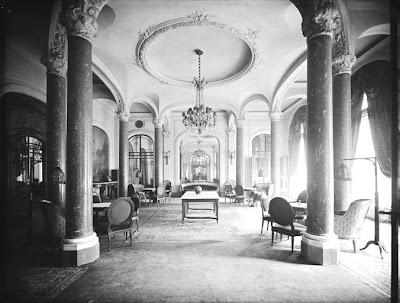

In casting Billy Smith (1871-1937) as the victorious protagonist of Salutat, Eakins brought attention to a relatively little known featherweight fighter. "It was 1898", wrote later Smith, "when Mr. Eakins came to a Boxing Club, to get a modle [sic] for his first fight picture, titled Between Rounds. He choose [sic] me... Mr. Eakins, to me was a gentleman and an artist, and a realist of realists. In his work he would not add or subtract. I recall... I noticed a dark smear across my upper lip, I asked Mr. Eakins what it was, he said it was my mustache, I wanted it of [sic], he said it was there, and there it stayed. You can see that he was a realist." In Between Rounds, he recorded a documented fight at the Arena on April 22, 1898, that Smith went on to lose. The second fanning him with a towel is Billy McCarney. Bending over the ropes is Elwood McCloskey, known as "The Old War Horse." They were regulars in the old Arena at Broad and Cherry streets in Philadelphia where Eakins and his friends were faithful attendants. Clarence W. Cranmer, who is sitting at the table as timer, was a local newspaperman and a close friend of the artist.


[...] Eakins was clearly fascinated by the [...] rough, low-class world of the Arena [...], and through various details he emphasized its class distinctions. For example, in Salutat the contrast between the red of Billy Smith's head and neck and the pallor of the rest of his body indicates that he makes his living from weekday labor, and has picked up a sunburn from working outdoors. After posing for Between Rounds and Salutat, Billy Smith became a companion and a comfort to Eakins until the artist’s death. When the elderly Eakins could no longer move around his house in the months before his death, Smith relieved his pain with therapeutic massages and moved the artist from room to room when his legs failed him.



[...] Perhaps the most disturbing of these paintings is Taking the Count, an awkwardly resolved composition, which shows two boxers at the climax of a fight. Kneeling at the right is Jack Daly of Wilmington, looking younger (both were born in 1873), whose square jaw, callow good looks, and blank expression provide a kind of parody of the vacuous poster boys pictured by illustrators like Joseph Leyendecker and James Montgomery Flagg. Daly has clearly been brought down by a blow to the jaw. He rests on one knee, looking up at the crotch of his adversary, evidently deciding to rise and take more punishment. At the left, his triumphant antagonist, Charlie McKeever, whose face is older, more irregular, and more brutal, stands ready to sock Mack again if he attempts to get up. Between the two figures is the tuxedo-wearing referee, Henry Walter Schlichter, who is counting off seconds. His eyes do not engage either of the fighters, and his pose is stiff and awkward - one writer has compared him to a sleepwalker. Perhaps the most beautifully rendered passage is the boxing shorts of the older, victorious boxer, Charlie MacKeever. Eakins lavished care on every stretch and seam, particularly in the groin area, which seems to bulge with triumph.


McKeever's short also draw attention to the oddest feature of the painting. Eakins included a self-portrait, as witness and voyeur, within the narrow wedge created by the boxer's legs, just below his crotch. The placement is sly - a kind of furtive joke that might easily pass undetected. Yet, once one notices it, the painting never looks quite the same. For surely it is no accident that Eakins juxtaposed himself with the male genitals. [...] The implication of McKeever's genitals become even more disturbing in the oil study for his painting, in which Eakins sketched the figures completely nude. Thus, it is clear that the glance of the downed boxer is directed toward the victor's penis. In addition, the gesture of the referee's hand seems like a continuation of the penis, shoving it toward the kneeling figure's face and mouth. The other fight pictures also seem devote inordinate attention to crotches and buttocks. In Betweens Rounds, for example, Billy Smith's bulging crotch is almost at the center of the painting, and is certainly the most brightly lit area of the composition. In The Wrestlers, the figures are locked in a quasi erotic embrace, and the victorious figure has achieved "a crotch hold", in wrestling parlance. Eakins also showed two figures at the upper right hand corner - one clothed, the other in his boxing shorts - who are cut off at the waist so that our eyes focus on the groin area. Salutat differs from the other painting in the series in that the boxer's crotch is turned away from us, and turned toward the audience, which is staring at this area and applauding. Our view focuses on the buttocks of the victorious figure, which the water boy behind him is also staring at intently.


(from Henry Adams, Eakins revealed : the secret life of an American artist)







